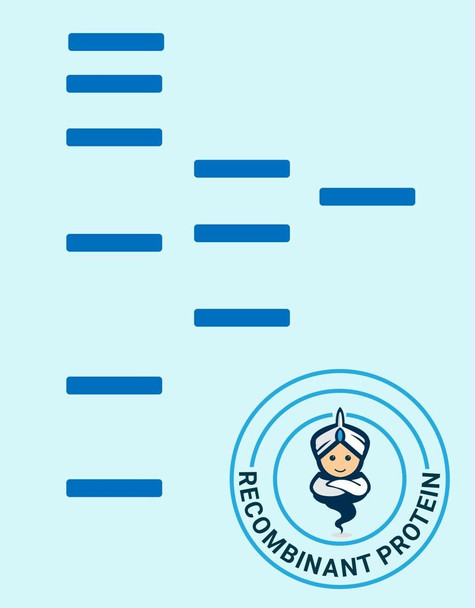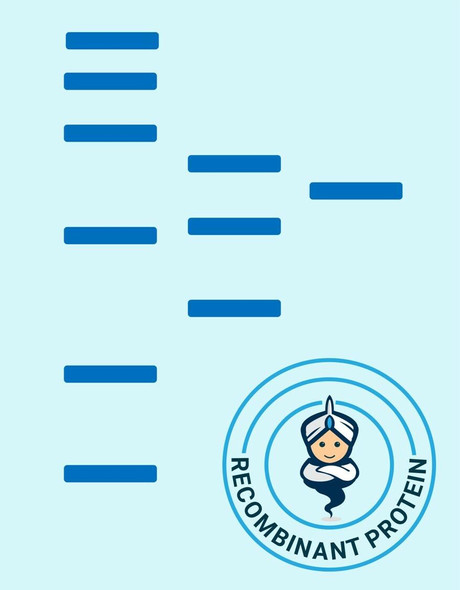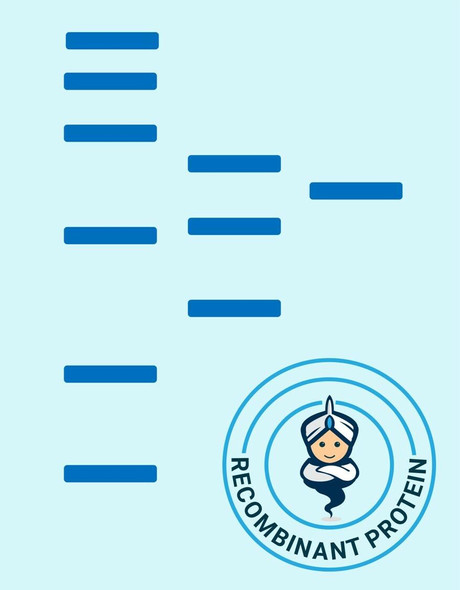Mouse IGF1 Recombinant Protein (RPPB0424)
- SKU:
- RPPB0424
- Product type:
- Recombinant Protein
- Size:
- 50ug
- Species:
- Mouse
- Target:
- IGF1
- Synonyms:
- Somatomedin C
- IGF-I
- IGFIA
- IGF1
- Source:
- Escherichia Coli
- Uniprot:
- P05017
Description
| Product Name: | Mouse IGF1 Recombinant Protein |
| Product Code: | RPPB0424 |
| Size: | 50µg |
| Species: | Mouse |
| Target: | IGF1 |
| Synonyms: | Somatomedin C, IGF-I, IGFIA, IGF1. |
| Source: | Escherichia Coli |
| Physical Appearance: | Sterile Filtered White lyophilized (freeze-dried) powder. |
| Formulation: | The protein was lyophilized with no additives. |
| Solubility: | It is recommended to reconstitute the lyophilized IGF1 in sterile 18M?-cm H2O not less than 100µg/ml, which can then be further diluted to other aqueous solutions. |
| Stability: | Lyophilized IGFI although stable at room temperature for 3 weeks, should be stored desiccated below -18°C. Upon reconstitution IGF-1 should be stored at 4°C between 2-7 days and for future use below -18°C.For long term storage it is recommended to add a carrier protein (0.1% HSA or BSA).Please prevent freeze-thaw cycles. |
| Purity: | Greater than 98.0% as determined by(a) Analysis by RP-HPLC.(b) Analysis by SDS-PAGE. |
| Amino Acid Sequence: | The sequence of the first five N-terminal amino acids was determined and was found to be Gly-Pro-Glu-Thr-Leu |
| Biological Activity: | The ED50, calculated by the dose-dependant proliferation of murine BALB\C 3T3 cells (measured by 3H-thymidine uptake) is < 1.0 ng/ml, corresponding to a specific activity of 1MU/mg. |
The somatomedins, or insulin-like growth factors (IGFs), comprise a family of peptides that play important roles in mammalian growth and development. IGF1 mediates many of the growth-promoting effects of growth hormone (GH; MIM 139250). Early studies showed that growth hormone did not directly stimulate the incorporation of sulfate into cartilage, but rather acted through a serum factor, termed 'sulfation factor,' which later became known as 'somatomedin' (Daughaday et al., 1972). Three main somatomedins have been characterized: somatomedin C (IGF1), somatomedin A (IGF2; MIM 147470), and somatomedin B (MIM 193190) (Rotwein, 1986; Rosenfeld, 2003).
Insulin-Like Growth Factor I mouse Recombinant produced in E.Coli is a single, non-glycosylated, polypeptide chain containing 70 amino acids and having a molecular mass of 7600 Dalton. IGF-I is purified by proprietary chromatographic techniques.
| UniProt Protein Function: | IGF1: The insulin-like growth factors, isolated from plasma, are structurally and functionally related to insulin but have a much higher growth-promoting activity. May be a physiological regulator of [1-14C]-2-deoxy-D-glucose (2DG) transport and glycogen synthesis in osteoblasts. Stimulates glucose transport in rat bone-derived osteoblastic (PyMS) cells and is effective at much lower concentrations than insulin, not only regarding glycogen and DNA synthesis but also with regard to enhancing glucose uptake. Defects in IGF1 are the cause of insulin-like growth factor I deficiency (IGF1 deficiency). IGF1 deficiency is an autosomal recessive disorder characterized by growth retardation, sensorineural deafness and mental retardation. Belongs to the insulin family. 3 isoforms of the human protein are produced by alternative splicing. |
| UniProt Protein Details: | Protein type:Secreted; Motility/polarity/chemotaxis; Secreted, signal peptide Cellular Component: extracellular space; cell soma; extracellular region; intracellular Molecular Function:integrin binding; protein serine/threonine kinase activator activity; insulin-like growth factor receptor binding; protein binding; growth factor activity; hormone activity; steroid binding; insulin receptor binding Biological Process: positive regulation of transcription, DNA-dependent; regulation of protein metabolic process; chondroitin sulfate proteoglycan biosynthetic process; exocrine pancreas development; water homeostasis; positive regulation of glucose import; positive regulation of fibroblast proliferation; proteoglycan biosynthetic process; inner ear development; positive regulation of DNA binding; muscle hypertrophy; nervous system development; positive regulation of mitosis; positive regulation of protein import into nucleus, translocation; regulation of establishment and/or maintenance of cell polarity; regulation of calcium ion transport; positive regulation of cell growth; positive regulation of phosphoinositide 3-kinase cascade; cell activation; positive regulation of peptidyl-tyrosine phosphorylation; insulin-like growth factor receptor signaling pathway; branching morphogenesis of a tube; response to heat; regulation of gene expression; positive regulation of fat cell differentiation; positive regulation of transcription from RNA polymerase II promoter; alveolus development; positive regulation of epithelial cell proliferation; negative regulation of apoptosis; positive regulation of insulin-like growth factor receptor signaling pathway; positive regulation of smooth muscle cell proliferation; myoblast proliferation; positive regulation of glycogen biosynthetic process; negative regulation of caspase activity; detection of mechanical stimulus involved in sensory perception; positive regulation of activated T cell proliferation; positive regulation of smooth muscle cell migration; regulation of translation; negative regulation of cell proliferation; glial cell differentiation; positive regulation of MAPKKK cascade; mammary gland development; positive regulation of cell proliferation; regulation of steroid hormone receptor signaling pathway; positive regulation of granule cell precursor proliferation; regulation of protein amino acid phosphorylation; phosphoinositide-mediated signaling; multicellular organism growth; myotube cell development; satellite cell compartment self-renewal involved in skeletal muscle regeneration; memory; regulation of cell proliferation; myoblast differentiation; cell proliferation; positive regulation of protein kinase B signaling cascade; positive regulation of osteoblast differentiation; positive regulation of tyrosine phosphorylation of Stat5 protein; positive regulation of glycolysis; blood vessel remodeling; positive regulation of Ras protein signal transduction; cell development; positive regulation of DNA replication; lung development |
| UniProt Code: | P05017 |
| NCBI GenInfo Identifier: | 56405309 |
| NCBI Gene ID: | 16000 |
| NCBI Accession: | P05017.2 |
| UniProt Secondary Accession: | P05017,P05018, Q6LDP4, Q8C4U6, |
| UniProt Related Accession: | P05017 |
| Molecular Weight: | 17,623 Da |
| NCBI Full Name: | Insulin-like growth factor I |
| NCBI Synonym Full Names: | insulin-like growth factor 1 |
| NCBI Official Symbol: | Igf1 |
| NCBI Official Synonym Symbols: | Igf-1; Igf-I; C730016P09Rik |
| NCBI Protein Information: | insulin-like growth factor I; somatomedin |
| UniProt Protein Name: | Insulin-like growth factor I |
| UniProt Synonym Protein Names: | Somatomedin |
| UniProt Gene Name: | Igf1 |
| UniProt Entry Name: | IGF1_MOUSE |










